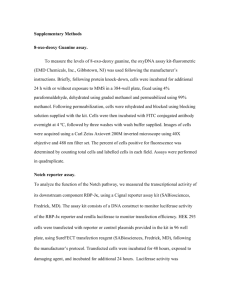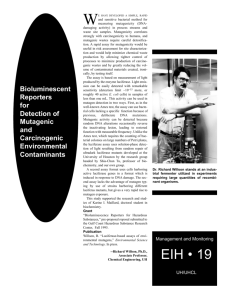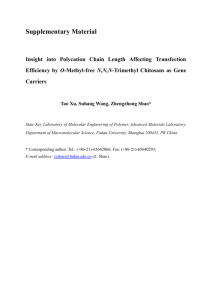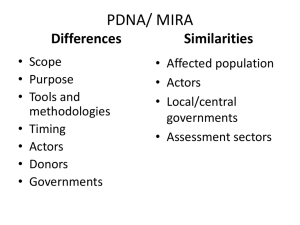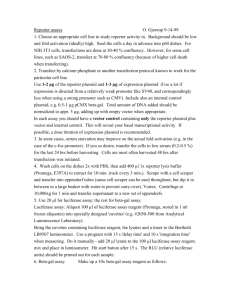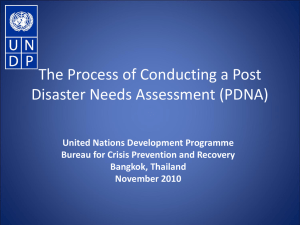An evaluation of in vitro and in vivo toxicity of chitosan/pDNA
advertisement
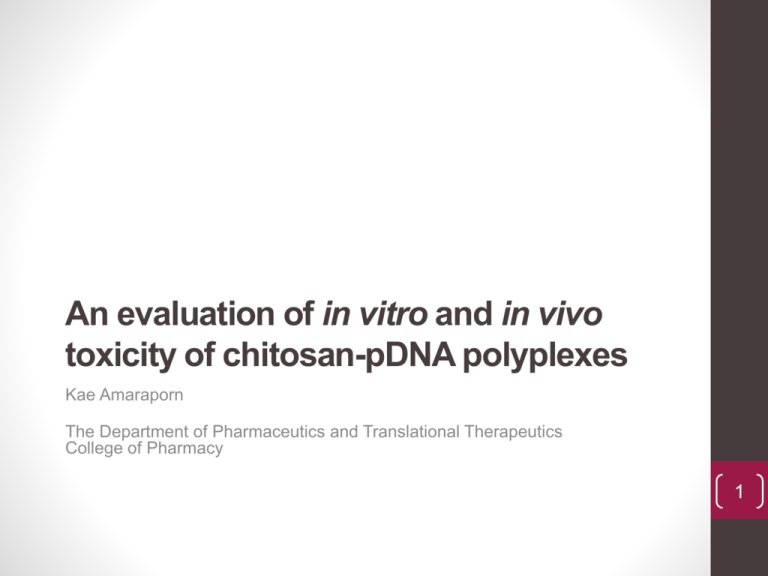
An evaluation of in vitro and in vivo toxicity of chitosan-pDNA polyplexes Kae Amaraporn The Department of Pharmaceutics and Translational Therapeutics College of Pharmacy 1 Gene delivery to lung • The transmission of DNA encoding for therapeutic gene or protein into the target cells for prevention or treatment of disease • Potential treatment for • Cystic fibrosis, Asthma • Advantages 1. 2. 3. Easily accessible via airways Large surface area for transfection Reduces the risk of systemic side effects • Disadvantages 1. 2. Repulsion between DNA & cell membrane due to same charge Enzymatic degradation 2 Mohammadi, Z., et al., In vivo transfection study of chitosan-DNA-FAP-B nanoparticles as a new non viral vector for gene delivery to the lung. Int J Pharm, 2011. 421(1): p. 183-8. Albelda, S.M., R. Wiewrodt, and J.B. Zuckerman, Gene therapy for lung disease: hype or hope? Ann Intern Med, 2000. 132(8): p. 649-60. Cationic polymers:DNA complex • • Storrie, H. and D.J. Mooney, Sustained delivery of plasmid DNA from polymeric scaffolds for tissue engineering. Adv Drug Deliv Rev, 2006. 58(4): p. 500-14. Shan, Y., et al., Gene delivery using dendrimer-entrapped gold nanoparticles as nonviral vectors. Biomaterials, 2012. 33(10): p. 3025-35. 3 Bacterial plasmids • Bacterial plasmids are circular DNA which can replicated independently of the bacterial chromosome. • Bacterial DNA is rich in unmethylated CpGs • activate the immune system • induce inflammatory response (in vivo) • decrease transgene expression • This study, we studied 2 types of pDNAs 1. CpG(-) is a plasmid free of CpG 2. CpG(+) is a plasmid containing CpG www.qiagen.com 4 Objectives 1. To characterized and optimized chitosan/pDNA polyplex formulations 1. Size and charge 2. Ability to condense plasmids 2. To investigate the toxicity and transfection efficiency in A549 and HEK293 1. MTS assay 2. Luciferase assay 3. To investigate the inflammatory response induced by the polyplexes in a mouse model 5 Experiments and Results 6 Objectives 1. To characterized and optimized chitosan/pDNA polyplex formulations 1. Size and charge 2. Ability to condense plasmids 2. To investigate the toxicity and transfection efficiency in A549 and HEK293 1. MTS assay 2. Luciferase assay 3. To investigate the inflammatory response induced by the polyplexes in a mouse model 7 Preparation of the chitosan/pDNA polyplex (+) charged polyelectrolyte was poured into (-) charged polyelectrolyte then vortexted for 20-30 s leading to the formation of the polyplexes 30 min pDNA Dextran sulfate *pDNA 50 ug/ml *CH:DS = 10:1 (w/w) *Concentration of chitosan depends on N/P ratios Chitosan in Acetate buffer CH/DS-pDNA nanoplex 8 Characterization Size Charge CH/CpG(-) CH/CpG(+) 9 N/P 100 N/P 60 N/P 20 N/P 10 N/P 5 N/P 1 pDNA • 1% Agarose gel contains ethidium bromide loaded with CH/CpG(+) polyplexes. • Chitosan can entrapped pDNA and inhibit DNA migration at N/P ratios > 1. DNA ladder Gel Retardation Assay 10 Objectives 1. To characterized and optimized chitosan/pDNA polyplex formulations 1. Size and charge 2. Ability to condense plasmids 2. To investigate the toxicity and transfection efficiency in A549 and HEK293 1. MTS assay 2. Luciferase assay 3. To investigate the inflammatory response induced by the polyplexes in a mouse model 11 Cell lines • A549 • Human lung carcinoma • HEK293 • Human embryonic kidney 12 www.atcc.org Cationic polymers:DNA complex • • Storrie, H. and D.J. Mooney, Sustained delivery of plasmid DNA from polymeric scaffolds for tissue engineering. Adv Drug Deliv Rev, 2006. 58(4): p. 500-14. Shan, Y., et al., Gene delivery using dendrimer-entrapped gold nanoparticles as nonviral vectors. Biomaterials, 2012. 33(10): p. 3025-35. 13 Transfection efficiency • Firefly luciferase activity assay • Firefly luciferase is • 61kDa protein – cosubstrate to catalyzes luciferin oxidation • sensitive assay to study gene expression 14 www.promega.com Transfection experiment 24-well plate 1 day 0h CH/pDNA 4h 24 h PBS and RLB Luciferase assay and Micro BCA assay 48 h 15 Luciferase expression CH/CpG(-) CH/CpG(+) 16 MTS assay • MTS is bioreduced by cells into formazan (color). • The quantity of formazan production is proportional to number of living cells. 18 www.promega.com MTS assay 96-well plate 1 day 0h CH/pDNA 4h 48 h MTS reagent 19 Cytotoxicity assay: MTS CH/CpG(-) CH/CpG(-) CH/CpG(+) CH/CpG(+) 20 Objectives 1. To characterized and optimized chitosan/pDNA polyplex formulations 1. Size and charge 2. Ability to condense plasmids 2. To investigate the toxicity and transfection efficiency in A549 and HEK293 1. MTS assay 2. Luciferase assay 3. To investigate the inflammatory response induced by the polyplexes in a mouse model 23 In vivo study CH/pDNA polyplexes CH/pDNA polyplexes 24 h 1h C57Bl/6 (n=6) • Luciferase assay • Micro BCA assay BAL fluid Supernatant from homogenized lung 24 • • • Total cell count Total protein/LDH Cytokines Luciferase expression in mice lungs RLU/mg total Protein 50000 ** 40000 30000 20000 10000 0 ol o C (-) r nt ) pG H C a os pG /C /C C H ) n (+ C t hi pG (+ C Mice treated with CH/CpG(-) shows highest luciferase expression. 25 Number of cells in BAL fluids A • Mice treated with CH/CpG(-) shows maximum number of total cell count in BAL fluids. • Among three types of white blood cells, BAL fluids contain high neutrophils in both types of polyplexes. ** 1500 1000 500 ) (+ pG C pG /C H C C hi to sa n ) (+ (-) pG /C H C C on tr ol 0 B 120 Macrophages Neutrophils Lymphocytes 100 80 60 40 20 26 ) (+ pG sa to hi C C ) /C H C C H /C pG pG (+ (-) ol tr on n 0 C % of cells from total cells Total number of cells/ Mouse x103 2000 Total protein and LDH activity 27 Cytokines A. B. C. D. E. IL-6 IL-12 KC MIP-1α TNF-α 28 Conclusion • Characteristic of Chitosan/pDNA polyplex • size 100-170 r.nm • charge 20-30 mV • CH/pDNA polyplex shows low cytoxicity in A549 and HEK293. There is no difference in toxicity between the nanoplex created using CpG(-) or CpG(+). • The polyplex prepared from from CpG-free plasmids shows … • higher transgene expression in A549 and in mice lungs • less inflammation in vivo • N/P ratio and DNA content of Chitosan/pDNA polyplex plays an important role in achieving high gene expression with minimal toxicity and inflammation. 29 Future work • To study lung histopathology of mice when treated with the chitosan/pDNA polyplex • Lung abnormalities • Abnormal inflammatory infiltrates • To develop chitosan/pDNA polyplex formulation which can form complex at high concentration and give high transfection efficiency • To investigate the difference between nasal instillation and aerosol delivery 30
